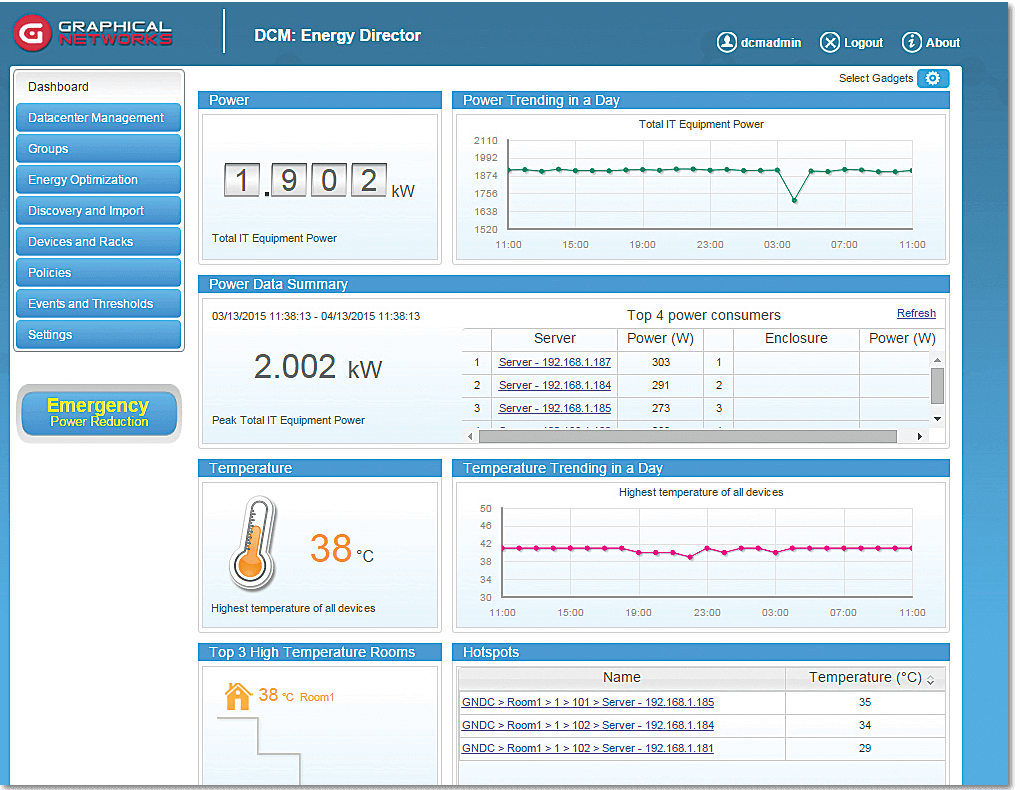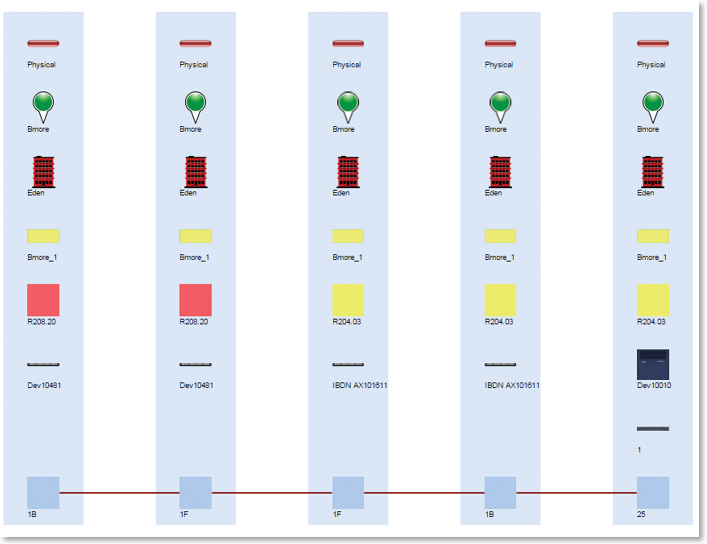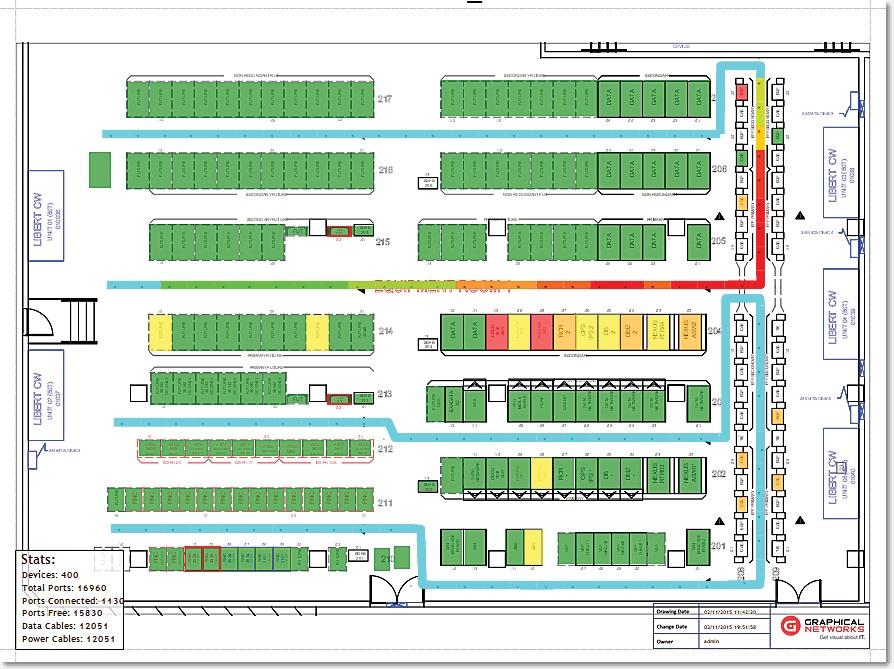 DCIM, which stands for Data Center Infrastructure Management, gives data center managers a central repository from which they can manage their data centers’ assets, space, power, cabling, cooling, and downtime. DCIM makes managing the ever-expanding ecosystems in data centers less daunting: with DCIM software, cable and circuit outages can be traced and resolved, new equipment can be placed, old equipment can be maximized, power capacity can be optimized, and last but not least: you can clearly see which assets you have and where they are.
DCIM, which stands for Data Center Infrastructure Management, gives data center managers a central repository from which they can manage their data centers’ assets, space, power, cabling, cooling, and downtime. DCIM makes managing the ever-expanding ecosystems in data centers less daunting: with DCIM software, cable and circuit outages can be traced and resolved, new equipment can be placed, old equipment can be maximized, power capacity can be optimized, and last but not least: you can clearly see which assets you have and where they are.
Data center managers often see significant cost savings in expenditures on energy, new equipment, overall operational overhead…and the cost of downtime.
What is DCIM?
Ask 100 actual users to define DCIM software (even when they’re using it daily) and you’ll end up with 100 different definitions of what data center infrastructure management software is: DCIM is in the eye of the beholder. With that in mind, we’ll try and define DCIM without getting too user or vendor-specific:
DCIM is comprised of process and solutions for tracking, monitoring, and managing the power and data utilization of all of a data center’s IT-related assets (hardware and software) and infrastructure components (racks, trays, floor plan space, cooling units, and so on) that impact cost reduction and/or optimizing consumption in the data center.
DCIM 101: Who Uses DCIM Software?
Organizations using DCIM software need to find out some or all of the following about their data centers:
- Data, cooling, and power information
- Consumption of space resources
- IT resource growth patterns
- Capacity planning information (being able to plan and forecast when a resource is due to expire….or when a new purchase will be necessary)
- Resource utilization…how to best optimize and maximize existing resources such as rack capacity
Because DCIM can be a powerful way to automate certain data center operations, the potential ROI and savings from using the software means that DCIM is used by companies who want and need to shave off significant dollars from overall data center operational expenses.
DCIM 101: What are the Limitations of DCIM Software?
Although once upon a time, DCIM was hyped as something so powerful it could boil the ocean, the truth is: it can’t …sorry. DCIM is not a one-size-fits-all solution (nor should it be).
DCIM can come with a variety of different features: whatever solution you end up with will likely come with features your organization needs — and some features your organization has no use for.
There isn’t a single DCIM solution or DCIM vendor that will offer one product that works for everyone: it depends upon the pain points you’re hoping the software can help you solve. If you want a successful DCIM implementation, you need to do the legwork to ensure you understand what your organization’s unique needs are — and which DCIM solutions can best answer them.
DCIM 101: Forget Features, Think Pain
What’s a good rule of thumb when it comes to features in DCIM software? ‘Features are as features do.’ What? Features are great for when you’re choosing a luxury car: they’re neither here nor there when you need enterprise software. The truth is: features won’t whip your data center into shape unless you specifically need the feature to solve an existing pain point.
Identify where your data center is hurting….and what you think you might be able to address with a DCIM solution . Look for DCIM solutions that specifically address your data center’s hurt.
DCIM 101: What Kind of DCIM Do You Need?
To identify a DCIM solution that will meet your needs, start by determining what those needs are. What follows below is a list of the different functions that fall under the umbrella of DCIM — and which you may want in the DCIM solution you end up choosing.
-
Managing Assets with DCIM
When a server goes down, how long does it take you to find it? Managing assets is integral to the mission of DCIM. Your data center may have thousands of assets: do you need a way to accurately track all of these? Asset management in DCIM can help you do far more than just locate assets. Need to know what a server is connected to — or if the server will shut down when you disconnect that power strip? With a true asset management process and system in place, your data center can run more smoothly and you can reduce overhead costs. - Managing Floors & Racks with DCIM
Need to streamline and optimize space, rack unit utilization and the geographical location of physical assets? DCIM can help. With it, you can discover which spaces are underutilized and where new equipment should be placed. - Monitoring Temperature & Environmental Power with DCIM
Need real-time power and temperature readings that you can relate to the underlying IT components which are impacted? DCIM can give managers comprehensive views into energy usage — and thermal data — per-device, rack, room and for the overall data center. - Managing Cables & Circuits with DCIM
Need to manage your cables? Don’t get stuck with shelfware….if you need cable management, you need more than being able to manage from point A to point B.You probably want to be able to do the following with your cabling:
- Discover it
- Visualize it
- Trace it
- Create connectivity hierarchies (aka layers)
- Do all of the above easily – with clicks, not consultants
- Logical, Virtual and Application Views
With virtualization today being what it is, you may want to map which of your VM images run on which host. You could also want to grab other application data so you can map them to the correct virtual and physical host in the data center. You may also want the same device that you have logically depicted (in the network – serving specific VM images, applications, systems, and so on) to also be physically rendered with the correct cabinet and rack placements. - Computational Fluid Dynamics
DCIM works together with computational fluid dynamics: for optimal data center design, thermal patterns and complex airflow can be modeled and monitored. complex airflow and thermal patterns in the data center can be modeled and monitored.
DCIM 101: How Do You Find a DCIM Vendor?
If you are considering data center infrastructure management software for your organization’s pain points, take some advice from Aaron Neville: ‘only fools rush in’. Don’t be a fool and don’t rush in: do some solid research on which DCIM vendors are out there and what they can offer in terms of solving your pain points.
We recommend starting with a spreadsheet to compare the various DCIM vendors. List the vendors you are considering — and which features they offer that can fulfill your needs. After you’ve zeroed your list of vendors down to a handful, go further. Get a demo, ask for references (and then actually call them), find out how often the software is updated, user feedback and satisfaction surveys, and ask specific questions about how support works (ie: can you call a phone number and talk to an actual support person or is it a whole song and dance to get through to someone).
How reliable a DCIM vendor is doesn’t necessarily have much to do with how big they are. Commscope recently followed in the tracks of CA Technologies and discontinued their DCIM product — leaving their users with an unsupported solution. No company, or software, is ever ‘too big to fail’.
DCIM 101: Conclusion
DCIM is full of potential: potential to lower costs, increase operational efficiency, and reduce downtime. Choose the right solution and you can realize this potential; if choose a solution that doesn’t answer your pain points and you could end up with some expensive shelfware.
To end up with a successful DCIM solution, identify how you would define DCIM, discern which pain points you would like to solve with it, identify DCIM vendors that can help you do that — and then vet them.



